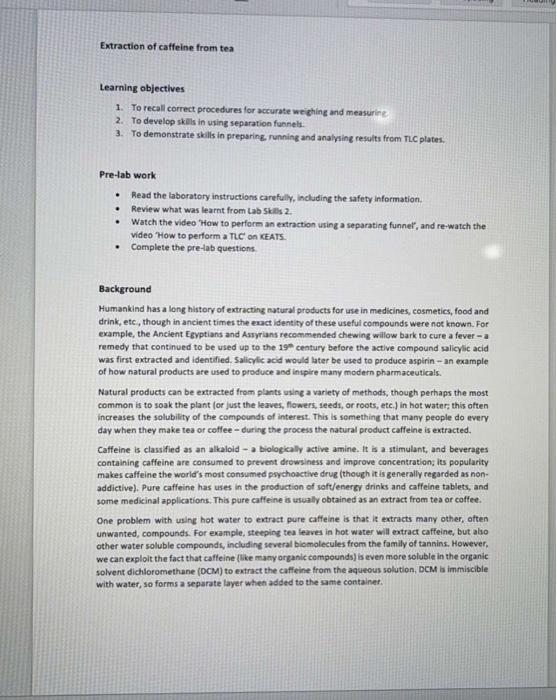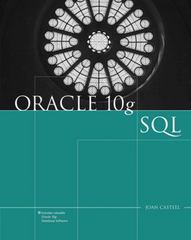Answered step by step
Verified Expert Solution
Question
1 Approved Answer
PLEASE HELP WITH THE RESULTS THE THREE PARTS WILL UPVOTE ASAP Extraction of caffeine from tea Learning objectives 1. To recall correct procedures for accurate
PLEASE HELP WITH THE RESULTS THE THREE PARTS WILL UPVOTE ASAP 
 Extraction of caffeine from tea Learning objectives 1. To recall correct procedures for accurate weighing and measurine 2. To develop skills in using separation funnels. 3. To demonstrate skills in preparing, running and analysing results from TLC plates. Pre-lab work . . . Read the laboratory instructions carefully, including the safety information. Review what was learnt from Lab Skills 2. Watch the video 'How to perform an extraction using a separating funnel, and re-watch the video How to perform a TLC on KEATS. Complete the pre-la questions Background Humankind has a long history of extracting natural products for use in medicines, cosmetics, food and drink, etc., though in ancient times the exact identity of these useful compounds were not known. For example, the Ancient Egyptians and Assyrians recommended chewing willow bark to cure a fever - a remedy that continued to be used up to the 19 century before the active compound salicylic acid was first extracted and identified. Salicylic acid would later be used to produce aspirin- an example of how natural products are used to produce and inspire many modern pharmaceuticals. Natural products can be extracted from plants using a variety of methods, though perhaps the most common is to soak the plant (or just the leaves, flowers, seeds, ar roots, etc.) in hot water; this often increases the solubility of the compounds of interest. This is something that many people do every day when they make tea or coffee - during the process the natural product caffeine is extracted. Caffeine is classified as an alkaloid- biologically active amine. It is a stimulant, and beverages containing caffeine are consumed to prevent drowsiness and improve concentration, its popularity makes caffeine the world's most consumed psychoactive drug (though it is generally regarded as non- addictive). Pure caffeine has uses in the production of soft/energy drinks and caffeine tablets, and some medicinal applications. This pure caffeine is usually obtained as an extract from tea or coffee. One problem with using hot water to extract pure caffeine is that it extracts many other, often unwanted, compounds. For example, steeping tea leaves in hot water will extract caffeine, but also other water soluble compounds, including several biomolecules from the family of tannins. However, we can exploit the fact that caffeine (like many organic compounds) is even more soluble in the organic solvent dichloromethane (DCM) to extract the caffeine from the aqueous solution, DCM is immiscible with water, so forms a separate layer when added to the same container, Results Insert in the box below a clear and readable hand-drawn image of your TLC plate (draw it yourself): [3 marks] Give an example calculation for one of your Rf values: [1 mark] Complete the table with your results from the TLC analysis: Lane on Distance Rf Identity TLC plate travelled value Solvent front [1 mark]
Extraction of caffeine from tea Learning objectives 1. To recall correct procedures for accurate weighing and measurine 2. To develop skills in using separation funnels. 3. To demonstrate skills in preparing, running and analysing results from TLC plates. Pre-lab work . . . Read the laboratory instructions carefully, including the safety information. Review what was learnt from Lab Skills 2. Watch the video 'How to perform an extraction using a separating funnel, and re-watch the video How to perform a TLC on KEATS. Complete the pre-la questions Background Humankind has a long history of extracting natural products for use in medicines, cosmetics, food and drink, etc., though in ancient times the exact identity of these useful compounds were not known. For example, the Ancient Egyptians and Assyrians recommended chewing willow bark to cure a fever - a remedy that continued to be used up to the 19 century before the active compound salicylic acid was first extracted and identified. Salicylic acid would later be used to produce aspirin- an example of how natural products are used to produce and inspire many modern pharmaceuticals. Natural products can be extracted from plants using a variety of methods, though perhaps the most common is to soak the plant (or just the leaves, flowers, seeds, ar roots, etc.) in hot water; this often increases the solubility of the compounds of interest. This is something that many people do every day when they make tea or coffee - during the process the natural product caffeine is extracted. Caffeine is classified as an alkaloid- biologically active amine. It is a stimulant, and beverages containing caffeine are consumed to prevent drowsiness and improve concentration, its popularity makes caffeine the world's most consumed psychoactive drug (though it is generally regarded as non- addictive). Pure caffeine has uses in the production of soft/energy drinks and caffeine tablets, and some medicinal applications. This pure caffeine is usually obtained as an extract from tea or coffee. One problem with using hot water to extract pure caffeine is that it extracts many other, often unwanted, compounds. For example, steeping tea leaves in hot water will extract caffeine, but also other water soluble compounds, including several biomolecules from the family of tannins. However, we can exploit the fact that caffeine (like many organic compounds) is even more soluble in the organic solvent dichloromethane (DCM) to extract the caffeine from the aqueous solution, DCM is immiscible with water, so forms a separate layer when added to the same container, Results Insert in the box below a clear and readable hand-drawn image of your TLC plate (draw it yourself): [3 marks] Give an example calculation for one of your Rf values: [1 mark] Complete the table with your results from the TLC analysis: Lane on Distance Rf Identity TLC plate travelled value Solvent front [1 mark]


Step by Step Solution
There are 3 Steps involved in it
Step: 1

Get Instant Access to Expert-Tailored Solutions
See step-by-step solutions with expert insights and AI powered tools for academic success
Step: 2

Step: 3

Ace Your Homework with AI
Get the answers you need in no time with our AI-driven, step-by-step assistance
Get Started


